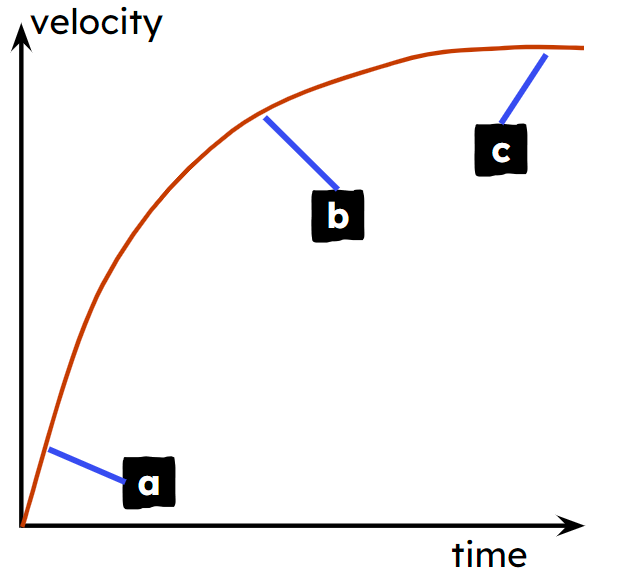Myths about teaching can hold you back


- Year 11•
- AQA•
- Higher
Terminal velocity (including graphical representation)
I can use the equation F = m × a to determine and explain the motion of falling objects.


- Year 11•
- AQA•
- Higher
Terminal velocity (including graphical representation)
I can use the equation F = m × a to determine and explain the motion of falling objects.
These resources were made for remote use during the pandemic, not classroom teaching.
Switch to our new teaching resources now - designed by teachers and leading subject experts, and tested in classrooms.
Lesson details
Key learning points
- An object that is dropped experiences a constant gravitational force towards the centre of the Earth
- For a falling object, air resistance acts in the opposite direction to the gravitational force
- As a falling object speeds up, the air resistance pushing up on it increases
- When the resultant force on a falling object becomes zero, the object reaches terminal velocity.
Keywords
Gravitational force - is a non–contact force that attracts objects with mass towards each other
Drag - is a force of a fluid on an object moving through it, in the opposite direction to the object’s motion
Resultant force - is the overall effect of the forces acting on an object
Terminal velocity - is the velocity of an object falling through a fluid, when there is zero resultant force
Common misconception
Pupils may believe that as air resistance increases, a falling object decelerates (slows down).
Analyse footage of a falling object played back in slow motion, or frame–by–frame, to show that the speed of a falling object increases, up to a maximum speed, and at no time does it slow down.
To help you plan your year 11 physics lesson on: Terminal velocity (including graphical representation), download all teaching resources for free and adapt to suit your pupils' needs...
To help you plan your year 11 physics lesson on: Terminal velocity (including graphical representation), download all teaching resources for free and adapt to suit your pupils' needs.
The starter quiz will activate and check your pupils' prior knowledge, with versions available both with and without answers in PDF format.
We use learning cycles to break down learning into key concepts or ideas linked to the learning outcome. Each learning cycle features explanations with checks for understanding and practice tasks with feedback. All of this is found in our slide decks, ready for you to download and edit. The practice tasks are also available as printable worksheets and some lessons have additional materials with extra material you might need for teaching the lesson.
The assessment exit quiz will test your pupils' understanding of the key learning points.
Our video is a tool for planning, showing how other teachers might teach the lesson, offering helpful tips, modelled explanations and inspiration for your own delivery in the classroom. Plus, you can set it as homework or revision for pupils and keep their learning on track by sharing an online pupil version of this lesson.
Explore more key stage 4 physics lessons from the Forces make things change unit, dive into the full secondary physics curriculum, or learn more about lesson planning.

Equipment
See additional materials.
Content guidance
- Risk assessment required - equipment
Supervision
Adult supervision required
Licence
Prior knowledge starter quiz
6 Questions
Q1.Which of the following forces acts on all objects near Earth surface?
Q2.An aeroplane produces a horizontal forwards thrust of 3200 N and a drag force of 2400 N opposes the movement.
What is the size of the resultant horizontal force acting on the aeroplane?
Q3.Which of the following is a statement of Newton’s Second Law of motion, using standard symbols?
Q4.Five cars, A, B, C, D and E, travel along a straight road. There are three forces acting on each car, the values of which are listed below.
Which of the cars are not accelerating?
Q5.What sized resultant force is needed to cause a lorry of mass 3000 kg to accelerate at 0.3 m/s$$^2$$?
Q6.Calculate the acceleration of a skydiver of mass 70 kg with a weight of 700 N and a drag force of 490 N acting on them. You do not need to give the unit.
Assessment exit quiz
6 Questions
Q1.Match the following key terms about terminal velocity to the correct description.
gravitational force -
Non–contact force that attracts objects with mass towards each other.
drag -
The force of a fluid acting on an object moving through it.
resultant force -
The overall effect of the forces acting on an object.
terminal velocity -
The velocity of a falling object when there is no resultant force.
Q2.Which of the following statements about an object falling through the atmosphere are correct?
Q3.Five objects, A, B, C, D and E, are falling towards Earth. There are two forces acting on each object, the values of which are listed below.
Which of the objects are at terminal velocity?
Q4.A graph of the velocity-time for a falling object is shown. Match the labelled points to the descriptions.

c -
no resultant force: object has reached terminal velocity
a -
resultant force is high
b -
resultant force is low

